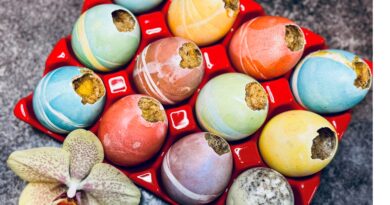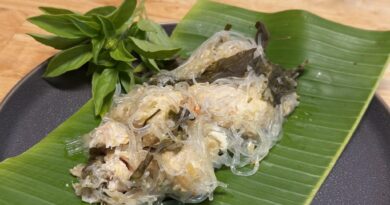Khao Soi Lao
Khao soi, which translates to “cut rice” referencing the fresh rice noodles which are typically used in the dish. Different variations of the dish can be found throughout Southeast Asia. It is more common in Myanmar (Burma), Laos and Northern Thailand. In Northern Thailand, you may find this dish is made with curry paste and coconut milk. This recipe is for the Lao version.
The broth itself is a basic broth, as most of the flavors comes from the topping. And oh my, that topping! There are so many layers of flavors packed in there. You get a salty umami flavor from the soybean paste, acidity from the tomatoes and a little heat from the chilies.
Th is noodle dish is easier than you’d expect. Even though it’s not a quick 15-minute meal, it’s definitely worth the effort on cool fall days, when you want to settle in with a warm bowl of noodle soup.
Notes:
- The Soybean Paste – I have tried a couple different types/brands of soybean pastes and was underwhelmed by most. I got in touch with a friend in California. She owns a Lao-Thai restaurant and I asked what she used in her Khao soi. The answer that I received was one I did not like. She used homemade soybean paste that she gets from her Hmong friends. So, I did some researching. Khao soi is enjoyed more in the Northern regions of Laos. You’ll hear about enjoying a bowl of Khao soi in Luang Prabang, but not so much in Savannakhet. And that is a hint to what ingredients may be used in the dish. Locals in the Northern regions typically make soybean paste, quite simply by fermenting soybean with salt. Sometimes, they may add chilies for spice. That’s it! If you look at soybean paste brands from Thailand, i.e. Healthy Boy or Pantai, you will find a few extra ingredients. I found the best soybean paste to use is the traditional Korean Doenjang because it is simply soybean fermented with salt. If you decide not to use the Korean soybean paste, I’d recommend finding a paste with as few ingredients as possible. All else fails, you can use the other soybean pastes. It will be different and by no means bad.

- Seasoning – with that said, depending on what brand of soybean paste or how much water you use, you may have to adjust your seasoning. You know the rule. Taste as you go. Also, you can use fish sauce in place of the salt. You’ll have to use two to three times more fish sauce than salt to get the same saltiness level. I used salt based on mom’s recommendation.
- The topping – can be made ahead of time. It can be kept in the fridge for up to three days. Or kept in the freezer for a month or two. Just thaw it out in the fridge over night before use. I have friends who would double or triple the recipe for the topping and freeze them for a later date. As previously mentioned, the broth itself is a basic broth and the topping makes the dish. You can even use store-bought low-sodium broth and add herbs and aromatics to it. Using topping that you’ve previously made and store-bought broth, you probably can turn it into a 15-minute meal. Heck! You can freeze the broth too!
- The accompaniments – use anything you can think of that you may use for pho, khao piek, mee kati, or khao poon. I’ve seen it all. When I was testing this recipe, I ate it everyday for four days. Enjoyed every bowl. I especially enjoyed the bowl with a squeeze of lime and a squirt of hoisin. Hey, it was the fourth day, I wanted to give a go and I totally enjoyed it.
Khao Soi Lao
Time: 1 hour
Serves: 6-8
Topping
1 lb ground pork
¼ cup oil
4-6 dried chilies (add more if you like spicy)
½ cup hot water
1 teaspoon salt (or 1 tablespoon fish sauce)
4 cloves garlic
½ cup soybean paste (I used Korean Doenjang)
1 teaspoon paprika
½ teaspoon msg (optional)
2 cups tomatoes, diced – I used about 6 Campari tomatoes
1 tablespoon sugar
Broth
2-3 lbs pork neck bones
16-18 cups water (approximate)
1 ½-2 tablespoons salt
1 teaspoon msg (Optional)
1 onion (peeled and split in half)
1 head of garlic (split in half)
A bundle of cilantro stems
Serve with
1 (14 oz) package of dried rice noodles (banh pho)
Accompaniments
Cilantro, roughly chopped
Scallions, diced
Bean sprouts
mint
Chili flakes
Lime wedges
• Prepare the broth in a large stock pot or Dutch oven over medium-high heat. Add water, pork bones, onion, cilantro stem (save leaves for garnish), the head of garlic, salt, and msg (if you’re using). Let it come to a boil, reduce the heat to medium and let it boil for 30-45 minutes.
• Soak the dried rice noodles in warm water.
• Rehydrate the dried chilies in a small bowl with the hot water for at least 15 minutes.
• Remove the rehydrated chilies from the water and pound in a mortar and pestle with 4 cloves of garlic. Pound until you get a paste. You can do this in food processor if you do not have a mortar and pestle.
• To make the topping, heat a wok or sauté pan over medium-high heat. Add oil and swirl it around the pan. Stir in the chili and garlic paste to the oil and cook until fragrant, about 30 seconds or so. Then add tomatoes and soybean paste. Stir occasionally until tomatoes start to break down. Finally, add in the ground pork, salt, paprika and sugar. Cook for 4-6 minutes until the pork has cooked completely through and the liquid has reduced slightly.
• Boil the rice noodles according to package instructions and drain.
• To serve, add cooked noodles and broth to a bowl. Top with pork topping and accompaniments. Enjoy!
Discover more from Crafts to Crumbs
Subscribe to get the latest posts sent to your email.



